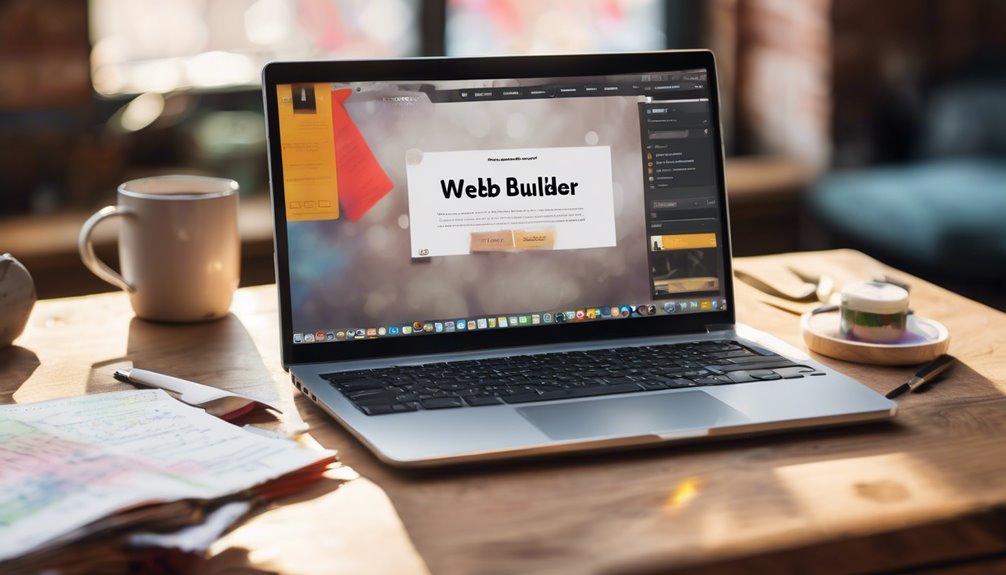As you venture into the world of website building, you'll quickly realize that not all builders are created equal. A good website builder should provide a seamless user experience, responsive design, and necessary integrations to connect with third-party services. But that's just the beginning. You'll also need e-commerce functionality, customization options, and website analytics to track user behavior. The question is, how do you find a builder that checks all these boxes and sets you up for online success?
Key Takeaways
- A good website builder should offer e-commerce functionality, website analytics, and customer feedback features to support online transactions and data-driven decisions.
- Responsive design is crucial for a superior user experience across various devices and screen sizes, with seamless adaptation to different screen resolutions and devices.
- Integrations with third-party services, such as Google Analytics and social media platforms, can expand the website's capabilities and enhance user experience.
- A good website builder should provide easy customization options, including control over visual elements, template editing, and CSS and HTML access for flexibility.
- Reliable customer support, with multiple support channels and prompt response times, is vital for resolving technical issues and ensuring online success.
Key Features to Look for in a Website Builder
When selecting a website builder, you'll want to prioritize features that cater to your specific needs and goals.
Consider the type of website you're building and the functionality you require. For instance, if you're building an e-commerce site, you'll want to look for features that support online transactions and inventory management.
Additionally, consider the importance of website analytics, which will help you track user behavior and make data-driven decisions.
You should also look for a website builder that allows for customer feedback, enabling you to understand your users' needs and preferences.
Understanding Responsive Design and Its Importance
A well-designed website adapts seamlessly to various devices and screen sizes, guaranteeing a superior user experience regardless of how visitors access your site.
Seamless adaptation to various devices and screen sizes is key to a superior user experience, no matter how visitors access your site.
This is achieved through responsive design, which involves creating a flexible layout that adjusts to different screen resolutions and devices.
You'll want to verify your website builder allows for responsive design, especially since most users access sites through mobile devices.
To get it right, you'll need to:
- Plan for breakpoints: Identify the points at which your design needs to adapt to different screen sizes.
- Test on various devices: Verify your site looks and functions well on different devices, from smartphones to desktops.
- Use device testing tools: Leverage tools that simulate different devices and screen sizes to test your site's responsiveness.
E-commerce Functionality: What You Need to Know
When building an e-commerce website, you'll need to integrate an online store that allows customers to browse and purchase products seamlessly.
You'll also require payment gateway options that securely process transactions, such as PayPal, Stripe, or Square.
Online Store Integration
How seamlessly can you integrate an online store into your website?
This is a vital aspect of e-commerce functionality. You want a website builder that allows you to set up an online store quickly and easily.
When evaluating online store integration, consider the following key factors:
- Storefront design: Can you customize the design of your online store to match your brand?
- Product management: How easily can you add, remove, and manage products in your online store?
- Online marketplace integration: Can you integrate your online store with popular marketplaces like Amazon or eBay?
A good website builder should provide a seamless online store integration experience, allowing you to focus on growing your business.
Payment Gateway Options
You've set up your online store, and now it's time to think about how customers will pay for their purchases.
A good website builder should offer various payment gateway options to make transactions seamless. Look for payment processors like PayPal, Stripe, or Square, which provide secure and reliable payment processing.
Verify your website builder supports gateway integrations with these processors, allowing you to accept payments effortlessly. Some website builders may offer built-in payment gateways, while others may require third-party integrations.
Consider the fees, security, and user experience when choosing a payment gateway. With the right payment gateway options, you can focus on selling and growing your online business.
Customization Options: Making Your Site Unique
Customization options are the key to making your website stand out from the crowd.
You want your site to reflect your brand identity, and that's where customization comes in. With a good website builder, you'll have control over visual elements like colors, fonts, and layouts.
Customization is key to reflecting your brand identity through control over visual elements like colors, fonts, and layouts.
This allows you to create a unique look that resonates with your target audience.
Three essential customization options to ponder:
- Template editing: Look for a builder that lets you edit templates to fit your needs.
- Drag-and-drop functionality: This feature makes it easy to add or remove elements from your site.
- CSS and HTML access: If you have coding skills, this option gives you total control over your site's design.
Integrations: How to Extend Your Website's Capabilities
Your website's design is only the beginning.
To take your site to the next level, you need to weigh integrations. These allow you to connect your website to third-party services, expanding its capabilities and enhancing user experience.
API connections enable seamless interactions between your site and external services, such as payment gateways, social media platforms, or email marketing tools. By integrating these services, you can automate tasks, collect data, and provide a more personalized experience for your visitors.
Look for a website builder that offers a range of integrations, including popular services like Google Analytics, Facebook, or Mailchimp. This will give you the flexibility to customize your site's functionality and stay competitive in the online market.
User-Friendly Interface: A Must-Have for Non-Techies
When choosing a website builder, you'll want an interface that's easy to navigate, even if you're not tech-savvy.
Look for options that offer intuitive navigation and drag-and-drop functionality, allowing you to build and customize your site without needing to write code. With these features, you'll be able to focus on creating a great website, rather than getting bogged down in technical details.
Easy Navigation Options
A good website builder should provide easy navigation options, allowing you to effortlessly move around the platform and access its various features.
This is vital for non-techies who want to build a website without getting overwhelmed by complex technicalities.
When it comes to navigation, you should look for the following key features:
- Intuitive menus: menus that are logically organized and easy to understand, making it simple to find what you need.
- Site maps: visual representations of your website's structure, helping you plan and organize your content more effectively.
- Clear categorization: features and tools grouped into logical categories, making it easy to find what you're looking for.
With these features, you'll be able to navigate the website builder with ease, focusing on building your website rather than getting bogged down in technical details.
Drag-and-Drop Functionality
Building a website without needing to write a single line of code is now a reality, thanks to drag-and-drop functionality, a key feature of modern website builders that allows you to create and arrange page elements with ease.
With drag-and-drop, you can select from a variety of website templates and customize them to fit your needs. Visual editors enable you to see the changes you make in real-time, making it easy to experiment with different layouts and designs.
You can add text, images, and other multimedia elements to your pages without needing to know how to code. This functionality makes it possible for you to focus on the content and design of your website, rather than the technical aspects of building it.
SEO Optimization: Boosting Your Online Visibility
How do you guarantee your website rises to the top of search engine rankings, increasing your online visibility and driving more traffic to your site?
By optimizing your website for search engines, you can boost your online presence and reach a wider audience.
To achieve this, you'll need to conduct thorough keyword research to identify relevant terms and phrases your target audience uses.
Three essential SEO strategies to get you started:
- Optimize your page titles and descriptions: Certify they accurately reflect your content and include target keywords.
- Use header tags and structured content: Organize your content with H1, H2, and H3 tags to improve readability and search engine crawlability.
- Build high-quality backlinks: Leverage relationships with other reputable websites to increase your authority and ranking potential.
Mobile Optimization: Reaching a Wider Audience
You're likely aware that most users access websites through mobile devices, making mobile optimization vital.
A good website builder should provide responsive design, ensuring your site adapts seamlessly to different screen sizes and devices.
Responsive Design Matters
The majority of online traffic now originates from mobile devices, making a responsive website design crucial for reaching a wider audience.
You need a website that adapts seamlessly to different screen sizes and devices.
A responsive design guarantees that your website's layout, content, and images adjust automatically to provide a superior user experience.
To achieve this, you'll need to implement the following key elements:
- Fluid grids: Use relative units instead of fixed pixels to create a flexible grid system.
- Media queries: Define breakpoints to apply different styles based on screen size and device type.
- Flexible images: Guarantee images scale proportionally to fit different screen sizes.
Seamless User Experience
A seamless user experience is crucial for mobile optimization, as it directly impacts how engaged your audience is with your website.
You need to guarantee that your site is optimized for various user personas, each with their unique needs and preferences. Intuitive navigation is key to achieving this.
You should organize your content in a logical and consistent manner, making it easy for users to find what they're looking for. A well-structured layout, clear typography, and prominent calls-to-action will also contribute to a positive user experience.
Affordable Pricing Plans: Finding the Right Fit
Pricing plans can make or break your decision to invest in a website builder, and finding the right fit is crucial to your online success.
Finding the right pricing plan is crucial to online success, as it can make or break your website builder investment.
You need to weigh your budget and requirements to guarantee you're getting the best value for your money.
When evaluating pricing plans, conduct a cost analysis and budget breakdown to determine which plan aligns with your needs.
Weigh the following key factors:
- Storage and bandwidth: Will the plan provide sufficient storage for your files and bandwidth for your traffic?
- Features and functionality: Does the plan offer the features you need, such as e-commerce integrations or SEO tools?
- Scalability: Will the plan allow you to easily upgrade or downgrade as your website grows or changes?
Reliable Customer Support: When You Need It Most
You've found a website builder that fits your budget, but what happens when you need help? Reliable customer support is vital when you're stuck or facing technical issues. A good website builder should offer multiple support channels, such as email, phone, or live chat.
| Support Channel | Response Time | Availability |
|---|---|---|
| 2-4 hours | 24/7 | |
| Phone | Immediate | 9am-5pm EST |
| Live Chat | Immediate | 24/7 |
When you submit a help ticket, you expect a prompt response from a knowledgeable support agent. Look for website builders that offer 24/7 support, with agents who can resolve your issues efficiently. This guarantees that your website is always up and running, with minimal downtime.
Frequently Asked Questions
Can I Use a Website Builder for a Blog?
You can definitely use a website builder for a blog, as they offer essential blog features like customizable templates and SEO optimization. You'll also appreciate the user-friendly content management systems that make publishing and updating content a breeze.
Do Website Builders Offer Free Trials or Demos?
You'll find most website builders offer free trials or demos, allowing you to take test runs and preview features before committing to a plan, giving you a hands-on feel for the platform's capabilities.
Can I Switch Website Builders if I'm Unhappy?
If you're unhappy with your current website builder, you can switch to a new one, but be prepared to reassess your design flexibility and cost comparison to guarantee a smooth shift that meets your evolving needs.
Do Website Builders Provide Website Hosting?
You'll find that most website builders offer hosting services, providing various server options and hosting flexibility. They'll handle the technicalities, so you don't need to worry about finding a separate hosting provider, unless you prefer more control over your site's hosting environment.
Can I Use My Own Custom Domain Name?
You can use your own custom domain name with most website builders, offering domain options that provide custom flexibility. You'll typically need to purchase the domain separately, then connect it to your website builder's platform.
Conclusion
You've got a solid grasp of what makes a good website builder. Now, it's time to put your knowledge into action. By prioritizing responsive design, e-commerce functionality, customization options, integrations, SEO optimization, mobile optimization, affordable pricing plans, and reliable customer support, you'll be well on your way to creating a website that truly resonates with your audience and drives online success. With the right tools and features, you'll be able to build a site that's both functional and visually appealing.


